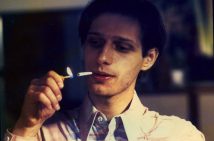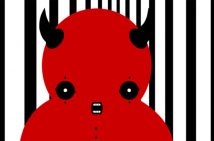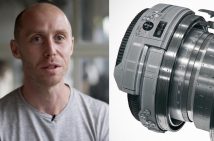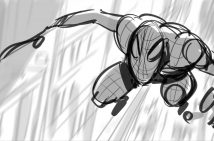Submarine Channel

Chunk: Kanizsa Hill Amazingness from LalaLand
Chunk: Kanizsa Hill Amazingness from LalaLand
In a sublime fusion of animation techniques – with just the right amount of live action thrown in – Kanizsa Hill is visual poetry in its purest form. The captivating, surrealist narrative of this animated short was conceived and created by young L.A-based filmmaker / power puff Evelyn Lee.
As she draws us into the tale of a human head which has been ripped untimely its ailing body, we follow the two physical entitities in their quest to re-connect – and find meaning in their abstract, parallel existences. Sound un petit peut pretentious? Well it’s not! That’s the beauty of this piece: Lee has refined and perfected her recipe to create an exquisite concoction which rests on just the point of the avant-garde-ometer.
Can you briefly introduce the story of Kanisza Hill, and how it came to be?
Basically, the story of Kanizsa Hill is about a person who gets shot and his head and body continue to exist independently from each other, and it’s their journey to find each other again. When I started writing the script, I recalled some stories from a friend of mine who was a soldier stationed in Iraq. That was the starting point, and from there I just let my mind go and run from thought to thought and memory to memory. I actually had the entire script written with the head, the tree, and the kanizsa figure, and I felt that something was missing from the story. Then I realized I had completely forgotten about the body. As soon as I put the body in, the script completely changed, and the story started to come together.
I read somewhere that the character in the story is a soldier, is this correct? If so, is there a political message underlying your film?
I would say the character is a soldier, although it isn’t necessarily important for the viewer to understand that while watching the film. I do try to stay away from an obvious political or social message, but I think I always in some way it manifests itself.
Would it be true to say the key issue raised in your film can be boiled down to: the disconnection between the objectivity of the body with its collection of material things, versus the subjectivity of the Kanisza triangle illusion in the head?
– Definitely. That is core the film. The body goes off and looks for these random objects, and calls them souvenirs. I always found souvenirs so interesting, because as an object, it’s just a t-shirt, a spoon, a hat, a fake coconut, but what makes an object a souvenir is that memory of being at a certain place at a certain time. The same can be said with a photograph. You can go on a trip, or have an experience, and it’s real, then as time passes that memory fades in your mind, and what was so real files away as if it were some sort of dream. The only proof that the memory existed is with some souvenirs and photos. That’s the reason why the body was pixilated. He’s actually walking thru photos I took from ground zero. When he’s holding that sign, behind him are other signs. They’re very washed out in the film, but they were the signs from ground zero that were looking for missing people. I didn’t want the viewer to watch it and identify the landscape as ground zero, or even identify the film with 9/11. I don’t mean to make light of the situation either, I just sometimes have a dry sense of humor. Really what it came down to was because there was a disconnection, the body would just collect material objects, misname them, and misuse them. Eventually he would use the chainsaw as a walking stick and completely destroy the city. Then there is the head, which is floating through thoughts and memories, floating in the blue sky, and without a body to ground it, the head becomes consumed in an illusion. A lot of people get the definition of a delusion and an illusion mixed. A delusion is something that doesn’t exist. An illusion is something that is created in the mind because of an error, but that doesn’t necessarily mean that it doesn’t exist. So much of the world is based around illusions and they can be seen as both negatives and positives. An example is like the idea of hope, it might be an illusion, but in some form it’s necessary for all people to have. There was a very deliberate choice in using the Kanizsa figures– it’s really a switch between the negative and positive space, either the fragments or an imaginary whole. In a sense the Kanizsa triangles are the mind’s souvenirs, so in order for the head and body to re-unite, the mind needs to let go of the illusions, and the body needs to let go of the material “souvenirs” he has collected.
There is something very powerful about the echo-y audio in compounding the dream-like frustration and confusion in the “body” sequences. How important was sound design in your film?
I think sound design was very important to the film, and Kari Rae Seekins was the sound designer. I had always passed Kari drawings, sketches, boards, scripts, animatics, anything I had, so that she was very much in tune with the story, the themes, the various layers, and elements to follow within the piece. I have always appreciated sound design that doesn’t only sound great, but also adds depth to the story – where it creates an emotional atmosphere and tone. We were very much in communication, and really Kari brought her flair to the sound design of the film.
Can you briefly talk us through the creative process that went into the making of Kanisza Hill?
Making Kanizsa Hill felt like jumping into a dark hole. Usually when I make something, I have some sort of vision that I see in my head, but because so much of this film was an experimentation in both concept and technique, I went with what felt right as opposed to what it looked like in my head. That was the sort of the jumping into the dark hole part, a lot of designs weren’t working, or there were happy accidents along the way, and there was a lot of searching for the right combination. I think with that approach, there is a danger of whether you’re in control of your work, or if your work is in control of you. Being in that darkness, it’s a constant struggle between the two. It did take a while to understand all the dualities within the dualities, and balancing them both visually and in the story. Once I started to realize and get control of what I was doing, I was able to climb out of the hole.
You’ve created a glorious fusion of analog (painting, drawing) and digital (photoshop, animation) techniques. What was your stylistic goal with this film?
So much of the concept of the film was about duality and contrasting elements and about joining the them together, so from I knew I wanted to use a lot of different techniques, and really wanted to push that as far as possible. I wanted to make the photo look drawn or painterly and make the drawings digital and diagram-like, and then reverse those techniques within the animation, so that overall when they were meshed together it was more unified, where one technique or style didn’t dominate the other. Textures were really important too – having that tactile, tangible feel especially with something abstract and geometric like the Kanizsa figures, and the dots and lines, also added that idea of blending opposites.
Biggest technical challenge?
How to shoot the body was a challenge because I had never done stop motion or pixilation before. Antonio Anagaran was the actor for the body, and he has phenomenal body control, so I have to give a lot of credit to him for making that work. Then the treatment of the body ended up taking a long time. I treated and drew on each frame in Photoshop because I wanted to keep the look drawn and unstable so that it contrasted enough from the head but was still similar enough.
How long did the whole process take (and was it a passion project)?
This film was my graduate thesis film from Cal Arts. Overall it took around two and a half years to make. A year and a half went to writing the script, the boards, and the designs, and a year went to production and post. There were no guidelines other than to make a film. Deadlines were loose so it allowed me to work at my own pace and to really experiment and develop the concepts. Because of that, it was definitely a passion project. After graduating from Cal Arts I was working a full time job, but at nights I worked on the film for about a year to completely finish it.
The end appears to be an optimistic reunion. Are the head and body destined to be together and live happily ever after?
I think that’s a possibility, and that’d be nice. But then…if it is…it came at a very big cost, the cost being cutting the tree down. If only there was a way for the head to tell the body to pick it up without cutting the tree down, maybe then it would be a happily ever after story? I guess that’s the where the disconnection is, and it comes down to what the tree itself represents, which was something that I wanted to leave open to interpretation. (But I will say that the voice of the narrator who shoots the person in the beginning, and the voice of the tree are the same person.) The end is about making a decision, you can’t have everything, you basically see both sides (the negative space, the positive space), and chose. The head is trying to figure it out, find a way to see both at the same time, and finally the body just makes the decision, the tree has been cut down. I don’t know whether it’s a good or a bad decision, or even if there is such a thing as a good or bad decision, but regardless it was necessary to move forward. Otherwise the characters would stay stagnant and in that predicament forever. But, what was the cost of that decision? You might notice in the backgrounds there are stock market signs, it all goes back to that fundamental saying in economics, there is no such thing as a free lunch. I have heard some people say that it does seem like an optimistic reunion, and others claim that it was sad that the tree was cut down. Either way, I think both sides are a little right and a little wrong.



